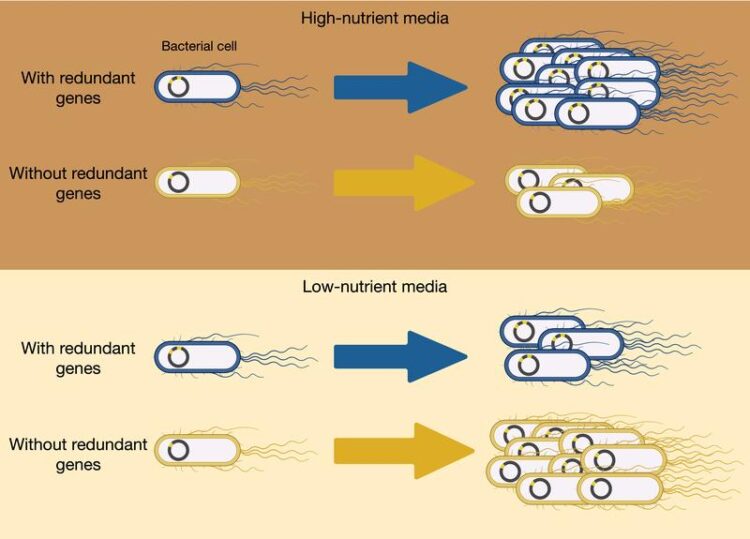The benefit of redundancy in biological systems

Genetic redundancy in translational components is costly under nutrient poor conditions, but beneficial under nutrient rich conditions.
Illustration: Max-Planck-Institut für Evolutionsbiologie
When viewed from an engineer’s perspective, biology is often messy and imperfect. For example, redundancy is a common feature of biological systems, with the job of one biological component overlapping with that of another. This work investigates whether some types of biological redundancy can – despite the apparent inefficiency – actually be beneficial.
Translation: a biological process with a high degree of redundancy
Translation is an energetically costly process by which cells convert genetic information into proteins. The decoding process is performed by ribosomes and transfer RNAs (tRNAs). These important biological molecules are themselves encoded in the cell’s genetic information, often by several (and sometimes hundreds!) of identical gene copies. For example, the commonly used laboratory bacterial strain Escherichia coli K-12 MG1655 contains seven copies of the ribosomal RNA (rRNA) genes and up to six copies of each tRNA gene. This apparent redundancy is, at first, unexpected; why pay the cost of maintaining numerous identical gene copies? One hypothesis is that more gene copies may allow more or faster production of ribosomes and tRNAs, leading to faster growth and division in supportive conditions. To test this hypothesis, Deepa Agashe’s group at the National Centre for Biological Sciences (India) teamed up with the Microbial Evolutionary Dynamics group at the Max Planck Institute for Evolutionary Biology (led by Jenna Gallie).
Levels of translational redundancy in E. coli can be manipulated in the laboratory
Various redundant rRNA and/or tRNA gene copies were removed from the E. coli K-12 MG1655 genome. The result was a panel of derived strains, each with a lower degree of translational redundancy than in the original strain. Biological assays were used to demonstrate that the gene deletion events lead to either a reduction in mature tRNA expression (via YAMAT-seq) and/or the slowing of translation (via -galactosidase reporter assays). These results show that (i) the genetic redundancy of E. coli translational components can be decreased, and (ii) the genetic reductions are reflected in the mature translational machinery.
More gene copies are beneficial under increased translational demand
The growth profiles of all strains were measured across different environments, in which nutrient availability ranged from poor to rich. Generally speaking, the lower-redundancy strains grew faster than the original strain when nutrients were scarce, but slower than the original strain when nutrients were freely available (see the accompanying Figure). These results are consistent with the initial hypothesis: genetic redundancy comes at a cost when translation is slow, and this cost is alleviated under conditions that support faster translation and growth.
Conclusion
This study has demonstrated that carrying multiple rRNA/tRNA gene copies can be beneficial under conditions that support increasingly faster translation and growth. More broadly, the results highlight that (apparent) redundancy can play a beneficial role in complex biological systems, particularly under changing environmental conditions.
Wissenschaftliche Ansprechpartner:
Dr. Jenna Gallie, Research Group Leader, Research Group Microbial Evolutionary Dynamics, Max.Planck-Institute for Evolutionary Biology, Plön
Originalpublikation:
Media Contact
All latest news from the category: Life Sciences and Chemistry
Articles and reports from the Life Sciences and chemistry area deal with applied and basic research into modern biology, chemistry and human medicine.
Valuable information can be found on a range of life sciences fields including bacteriology, biochemistry, bionics, bioinformatics, biophysics, biotechnology, genetics, geobotany, human biology, marine biology, microbiology, molecular biology, cellular biology, zoology, bioinorganic chemistry, microchemistry and environmental chemistry.
Newest articles

Largest magnetic anisotropy of a molecule measured at BESSY II
At the Berlin synchrotron radiation source BESSY II, the largest magnetic anisotropy of a single molecule ever measured experimentally has been determined. The larger this anisotropy is, the better a…

Breaking boundaries: Researchers isolate quantum coherence in classical light systems
LSU quantum researchers uncover hidden quantum behaviors within classical light, which could make quantum technologies robust. Understanding the boundary between classical and quantum physics has long been a central question…

MRI-first strategy for prostate cancer detection proves to be safe
Active monitoring is a sufficiently safe option when prostate MRI findings are negative. There are several strategies for the early detection of prostate cancer. The first step is often a…



